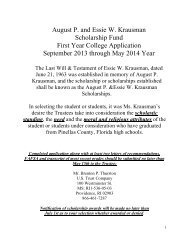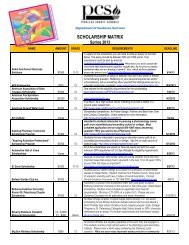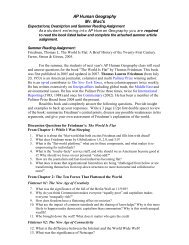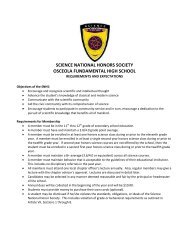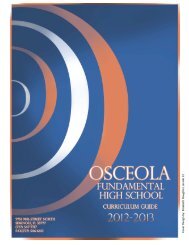Florida US History End-of-Course Assessment Test Item Specifications
Florida US History End-of-Course Assessment Test Item Specifications
Florida US History End-of-Course Assessment Test Item Specifications
- No tags were found...
Create successful ePaper yourself
Turn your PDF publications into a flip-book with our unique Google optimized e-Paper software.
Cognitive Complexity<br />
Cognitive complexity refers to the cognitive demand associated with an item. In the early years <strong>of</strong><br />
the FCAT program, the <strong>Florida</strong> Department <strong>of</strong> Education (DOE) used Bloom’s Taxonomy 1 to<br />
classify test items; however, Bloom’s Taxonomy is difficult to use because it requires an inference<br />
about the skill, knowledge, and background <strong>of</strong> the students responding to the item. Beginning in<br />
2004, DOE implemented a new cognitive classification system based upon Dr. Norman L. Webb’s<br />
Depth <strong>of</strong> Knowledge (DOK) levels. 2 The rationale for classifying an item by its DOK level <strong>of</strong><br />
complexity focuses on the expectations made <strong>of</strong> the item, not on the ability <strong>of</strong> the student. When<br />
classifying an item’s demands on thinking (i.e., what the item requires the student to recall,<br />
understand, analyze, and do), it is assumed that the student is familiar with the basic concepts <strong>of</strong><br />
the task. <strong>Test</strong> items are chosen for the EOC assessments and the FCAT 2.0 based on the NGSSS<br />
and their grade-level appropriateness, but the complexity <strong>of</strong> the items remains independent <strong>of</strong> the<br />
particular curriculum a student has experienced. On any given assessment, the cognitive<br />
complexity <strong>of</strong> a multiple-choice item may be affected by the distractors. The cognitive complexity<br />
<strong>of</strong> an item depends on the grade level <strong>of</strong> the assessment; an item that has a high level <strong>of</strong> cognitive<br />
complexity at one grade may not be as complex at a higher grade.<br />
The categories—low complexity, moderate complexity, and high complexity—form an ordered<br />
description <strong>of</strong> the demands an item may make on a student. For example, low-complexity items<br />
may require a student to solve a one-step problem. Moderate-complexity items may require<br />
multiple steps. High-complexity items may require a student to analyze and synthesize<br />
information. The distinctions made in item complexity ensure that test items will assess the<br />
depth <strong>of</strong> student knowledge at each benchmark. The intent <strong>of</strong> the item writer weighs heavily in<br />
determining the complexity <strong>of</strong> a test item. At the end <strong>of</strong> this section, three high school U.S.<br />
<strong>History</strong> items illustrate how a single concept may be assessed by items with increasing<br />
cognitive complexity.<br />
The pages that follow illustrate some <strong>of</strong> the varying demands that items might make at each<br />
complexity level for the U.S. <strong>History</strong> EOC <strong>Assessment</strong>. Note that items may fit one or more<br />
descriptions. In most instances, these items are classified in the highest level <strong>of</strong> complexity<br />
demanded by the item. Caution must be used in referring to the table <strong>of</strong> descriptors that is<br />
provided for each cognitive complexity level. This table is provided for ease <strong>of</strong> reference, but<br />
the ultimate determination <strong>of</strong> item complexity should be made considering the overall cognitive<br />
demand placed on a student. Another table provides the breakdown <strong>of</strong> the percentage <strong>of</strong> points<br />
by cognitive complexity level.<br />
1<br />
Bloom, B.S. et al. Taxonomy <strong>of</strong> Educational Objectives, Handbook I: Cognitive Domain. New York: McKay, 1956.<br />
2<br />
Webb, Norman L. and others. “Web Alignment Tool” 24 July 2005. Wisconsin Center <strong>of</strong> Educational Research. University <strong>of</strong><br />
Wisconsin-Madison. 2 Feb. 2006. http://www.wcer.wisc.edu/WAT/index.aspx.<br />
8 | U.S. <strong>History</strong> <strong>End</strong>-<strong>of</strong>-<strong>Course</strong> <strong>Assessment</strong> <strong>Test</strong> <strong>Item</strong> <strong>Specifications</strong> <strong>Florida</strong> Department <strong>of</strong> Education





